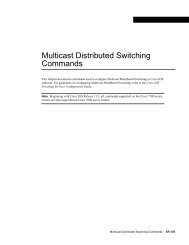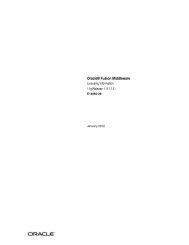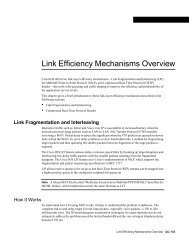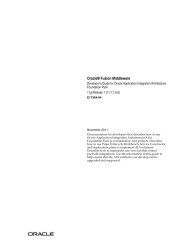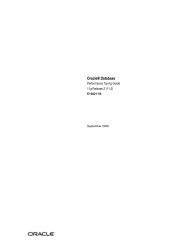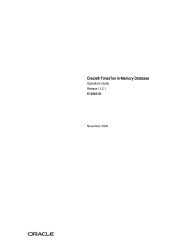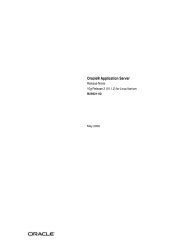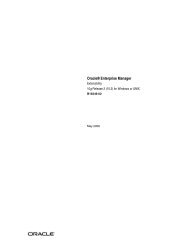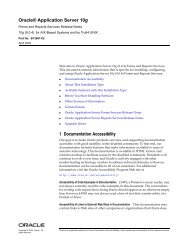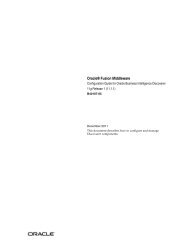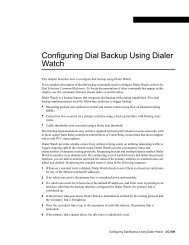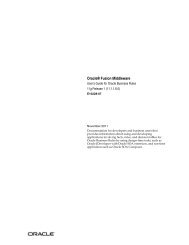Configuring 1- and 2-Port T1/E1 Multiflex Voice/WAN ... - docs.mind.ru
Configuring 1- and 2-Port T1/E1 Multiflex Voice/WAN ... - docs.mind.ru
Configuring 1- and 2-Port T1/E1 Multiflex Voice/WAN ... - docs.mind.ru
You also want an ePaper? Increase the reach of your titles
YUMPU automatically turns print PDFs into web optimized ePapers that Google loves.
Configuration Examples<br />
tag = 1, dest-pat = \Q+14085551000',<br />
answer-address = \Q',<br />
group = 0, Admin state is up, Operation state is down<br />
Permission is Both,<br />
type = pots, prefix = \Q',<br />
session-target = \Q', voice-port =<br />
Connect Time = 0, Charged Units = 0<br />
Successful Calls = 0, Failed Calls = 0<br />
Accepted Calls = 0, Refused Calls = 0<br />
Last Disconnect Cause is "10"<br />
Last Disconnect Text is ""<br />
Last Setup Time = 0<br />
The following text is sample output from the show dial-peer voice comm<strong>and</strong> for a VoIP dial peer:<br />
Router# show dial-peer voice 10<br />
<strong>Voice</strong>OverIpPeer10<br />
tag = 10, dest-pat = \Q',<br />
incall-number = \Q+14087',<br />
group = 0, Admin state is up, Operation state is down<br />
Permission is Answer,<br />
type = voip, session-target = \Q',<br />
sess-proto = cisco, req-qos = bestEffort,<br />
acc-qos = bestEffort,<br />
fax-rate = voice, codec = g729r8,<br />
Expect factor = 10,Icpif = 30, VAD = disabled, Poor QOV Trap = disabled,<br />
Connect Time = 0, Charged Units = 0<br />
Successful Calls = 0, Failed Calls = 0<br />
Accepted Calls = 0, Refused Calls = 0<br />
Last Disconnect Cause is "10"<br />
Last Disconnect Text is ""<br />
Last Setup Time = 0<br />
Configuration Examples<br />
This section includes three sample configurations to illustrate different scenarios:<br />
• Drop <strong>and</strong> Insert where PSTN <strong>and</strong> VoIP services are provided through the same service provider line.<br />
• Drop <strong>and</strong> Insert where PSTN <strong>and</strong> data services are provided through the same service provider line.<br />
• Drop <strong>and</strong> Insert where PSTN, data, <strong>and</strong> VoIP services are provided through the same service provider<br />
line.<br />
Note For additional examples, see <strong>Configuring</strong> Digital <strong>T1</strong> Packet <strong>Voice</strong> T<strong>ru</strong>nk Network Modules on Cisco<br />
2600 <strong>and</strong> 3600 Series Routers.<br />
Drop-<strong>and</strong>-Insert technology is one way to integrate old PBX technologies with VoIP. It allows you to take<br />
64-Kb DS0 channels from one <strong>T1</strong> or <strong>E1</strong> <strong>and</strong> digitally cross-connect them to 64Kb DS0 channels on another<br />
<strong>T1</strong> or <strong>E1</strong>.<br />
Drop <strong>and</strong> Insert allows individual 64Kb DS0 channels to be transparently passed, uncompressed, between<br />
<strong>T1</strong>/<strong>E1</strong> ports without DSP processing. Channel traffic is sent between a PBX <strong>and</strong> CO switch or other<br />
telephony device, allowing the use, for example, of some PBX channels for long-distance service through<br />
the PSTN while the router compresses others for interoffice VoIP calls. In addition, Drop <strong>and</strong> Insert can<br />
cross-connect a telephony switch (from the CO or PSTN) to a channel bank to provide external analog<br />
connectivity.<br />
<strong>Configuring</strong> 1- <strong>and</strong> 2-<strong>Port</strong> <strong>T1</strong>/<strong>E1</strong> <strong>Multiflex</strong> <strong>Voice</strong>/<strong>WAN</strong> Interface Cards on Cisco 2600 <strong>and</strong> 3600 Series Routers 21



